|

from
GreyFalcon Website
Of all the high-ranking German military leaders, Grand Admiral
Karl Dönitz is the most often overlooked, and yet he may have
been the most crucial for the story of Nazi survival and continued
secret weapons research.
After all, the secret preparations and
voyage of the U-234 to Japan, with its precious cargo of enriched
uranium and infrared fuses, could not likely have taken place
without his express knowledge, participation, and authorization.

Thus, outside Kammler's "think tank", he
was perhaps the one military leader of a conventional service arm to
know the full extent of Nazi Germany's actual advances in atom bomb
and other nuclear research.
Best known for his orchestration of the Nazi U-boat campaign against
British, Canadian, and American shipping, his alleged role in the
various survival myths is little known outside a small circle of
UFOlogy and World War Two researchers.
And of all the Nazi military leaders,
his selection by Adolf Hitler as the second Führer of the Third
Reich is, at best, problematical, unless viewed in the light of
these late war technology transfers and escaping Nazis.
|
Grand Admiral Karl Dönitz
Last
President of a United Germany
from
GreyFalcon Website
For a few brief weeks during late April and May of 1945,
a leader of Europe came to power, an honorable man,
respected even within the military councils of the
Allies.
That man was Grand Admiral
Karl Dönitz, commander-in-chief of the German
Navy, in overall command of German military forces in
the north, and at that tense moment engaged in arranging
sea and other transportation for the masses of refugees
fleeing from the eastern areas.
To his overwhelming
astonishment, Dönitz had been designated by Hitler as
his successor and head of state.
In his last political
testament executed at 4:00 a.m. on 29 April 1945, and
witnessed by Dr. Josef Göbbels, Reichsleiter
Martin Bormann, and Generals Wilhelm Burgdorf
and Hans Krebs, Adolf Hitler appointed Grand Admiral
Dönitz as,
"President of the
Reich and Supreme Commander of the Armed Forces ...
by virtue of my statement in the Reichstag on
September 1st, 1939 ..."
|
Why would Hitler have chosen Dönitz, a World War One veteran of the
High Seas Fleet of Kaiser Wilhelm, with the Kriegsmarine's
well-known imperialist culture and leanings that he represented, to
be his successor?
A conventional answer is afforded by the circumstances.
Betrayed on all sides - by Himmler and Göring themselves - a
desperate Hitler reached out to what he thought was the most loyal
conventional military service arm of the Wehrmacht, the Navy. But
the survival mythos contributes a very different perspective from
which to view Hitler's possible motivations.
Dönitz himself does nothing to allay those suspicions, either during
or immediately after the war.
According to Henry Stevens, who has
almost single-handedly investigated every lead - no matter how
implausible the detail - of the Nazi UFO and survival legends, Dönitz on more than one occasion alluded to the Navy's role in
exotic secret weapons research and in the construction of very
secret bases far from the Reich homeland.
In 1943, the Grand Admiral is reported to have stated that,
"the
German submarine fleet is proud of having built for the Führer, in
another part of the world, a Shangri-La on land, an impregnable
fortress."
[Henry Stevens, The Last Battalion
and German Arctic, Antarctic, and Andean Bases citing Col.
Howard A. Buechner and Capt. Wilhelm Bernhardt, Hitler's Ashes.]
Strange language for an admiral well-known for cold calculation
in military strategy and tactics, and not well-known to be
inclined to mystical statements.
Then again, in 1944, the Grand
Admiral doled out a little more information:
"The German Navy will have to
accomplish a great task in the future. The German Navy knows
all hiding places in the oceans and therefore it will be
very easy to bring the Führer to a safe place should the
necessity arise and in which he will have the opportunity to
work out his final plans."
[Ibid. citing Buechner and
Bernhardt]
But it was Dönitz's almost insane
remarks at Nuremberg that seemed to point clearly to one of the two
polar regions as the "site" for these "plans".
At Nuremberg he boasted of "an
invulnerable fortress, a paradise-like oasis in the middle of
eternal ice."
[Ibid., citing Willibald Mattern,
UFOs Unbekannte Flugobjekt? Letzte Geheimwaffe des Dritten
Reiches?]
Whatever the trustworthiness of Steven's
sources, these statements, plus the unusual behavior of some U-boats
at the end of the war, and the Germans' well-publicized pre-war
Antarctic scientific expedition, certainly seemed to spur the United
States into a sudden and intense postwar military interest in
Antarctica.
Again, since the basic facts are
well-known to but a small circle of World War Two and UFOlogy
researchers, it is worth recalling them in some detail.
-
U-530 surrendered at Mar del Plata, Argentina, on July 10, 1945
-
U-
977 surrendered at Mar del Plata, Argentina, on August 17, 1945
-
U-465 was scuttled off the coast of Patagonia in August 1945
-
Another U-boat of unknown number
surrendered to the Argentine Navy on June 10, 1945
When the U-530 and U-977 surrendered so late after the European
War's end, Allied intelligence was more than a little concerned, and
dispatched agents to interrogate the German officers.
They certainly
did not believe that the German captains had taken their ships on a
South Atlantic excursion of three to four months just to surrender
to the Argentines, as Captain Schäffer of the U-977 and
Captain Wermoutt of the U-530 actually, and apparently in all
seriousness, stated.
Stevens summarizes the Allies' real
concern - Nazi survival in no uncertain terms:
The Allies first believed that these U-Boats had taken persons of
special importance, perhaps even Adolf Hitler, from Germany to South
America. In light of this possibility both captains were held for
questioning.
Captain Schäffer, who surrendered last, was taken to
America for a month or so then to England for another period of
questioning. Both captains maintained that there had been no persons
of political importance deposited in South America.
Eventually the captains were released
although Schäffer found living in Occupied Germany intolerable and
relocated to South America. Captain Schäffer even went on to write a
book explaining his voyage and actions.
Unfortunately, nobody really believed Schäffer. Bernhardt, who
himself was aboard U-530, claims that American and British
Intelligence had learned that U-530 and U-977 did visit Antarctica
before landing in South America but the exact nature of their
mission eluded them.
A glimpse into this extraordinary mission and the high importance
afforded by the German Navy High Command (the Oberkommando
der KriegsMarine or OKM) to it can perhaps be afforded by
a glance of the alleged performance characteristics of the U-530.
In the spring of 1945, an old fashioned type U-boat with the number
530 was dry-docked after being damaged by a freighter which had
rammed it. As was typical for the Kriegsmarine, a new submarine,
probably a type XXI or further development of it, was launched at
approximately the same time, and was given the same service number,
an obvious ploy to confuse Allied military intelligence.
But why was the U-boat that actually
sailed to the South Atlantic and that later surrendered to Argentina
probably a type XXI or some derivative?
Because Captain Wilhelm Bernhardt, a pen
name of an actual crew member of Captain Wermoutt's U-530, let out a
significant piece of information; he stated that her submerged speed
was approximately 30 knots, an unheard of speed for a submerged
submarine in that day.
The only submarines in service in any navy in
the world capable of that performance at that time were the German
type XXI U-boats.
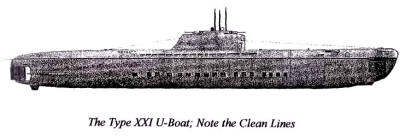
The type XXI U-boat, like most U-boats
in the German Navy by that time, was fitted with the special
schnorkel device that allowed its main diesel engines to operate
while submerged underwater.
It is quite possible that these newer
Type XXI U-boats also had the newer Schnorkels fitted with special
anti-radar coatings.
But the Type XXI was also outfitted with the
special "Walther" turbine, an underwater jet" device that utilized
hydrogen peroxide that allowed great underwater cruising speeds. In
effect, these turbines were "silent" engines allowing great
underwater speeds for limited durations of time. Thus, the Type XXI
had brought submarine technology and warfare to a new and
sophisticated level by the war's end.
But would even the Type XXI
have been able to brave the North and then South Atlantic Oceans, by
that point in the war all but Allied lakes?
There is some indication that not only were they successful in doing
so, but wildly so.
The Germans had adapted special new guidance systems to missiles,
and torpedoes. These systems included wire-guidance, as well as
magnetic proximity fuses. Stevens reports that on May 2, 1945, a
flotilla of U-boats, many of them Type XXIs, carefully husbanded by
Dönitz at Kristiansand fjord in Norway, departed in a wolf pack for
Iceland, making the traditional run through the straits between
Iceland and Greenland.
What happened next has been deleted from what passes as history, at
least in the countries of the former Allied Powers.
What happened
was the last great sea battle of the Atlantic. The German U-boat
convoy ran straight into an Allied naval battle formation. The result
was stunning. Using the new torpedoes... the Allied ships were
totally annihilated. Apparently the Allies never quite realized what
they had run into. Our only third-party report of the event was an
article in a South American newspaper which learned of the event.
A
quote (sic) from the only survivor of the attack is often quoted by
the underground German writers:
"May God help me, may I never again
encounter such a force"
- British destroyer captain.
This was reportedly carried in "El Mercurio
de Santiago"
from Chile, and "Der
Weg" a paper published by exiled Germans living in Buenos Aires,
Argentina.
The British consistently maintained a flotilla of destroyers,
accompanied occasionally by heavier units of light and heavy
cruisers, on station in these straits throughout the war.
The use of new torpedoes - whether wire-guided, acoustic-seeking, or
magnetic proximity-fused - leads once again back to Karnrnler's
"think tank" secret weapons empire. These torpedoes, plus the
high-submersible speeds and "proto-stealth" capabilities of the Type
XXI U-boats would have been more than a match for the British
destroyers on station between Iceland and Greenland.
The Coler coil came to the quick attention of the Kriegsmarine in
the early days of the Third Reich, which immediately classified it
at the highest level, and funded further research.
It is not hard to understand the Kriegsmarine's interest in the
Coler device. It is the perfect generator for submarine use. It
produces no exhaust and burns no fuel. It could be linked directly
to existing electric-drive vessels and run under water indefinitely.
Did the Germans actually accomplish this?
The underground German
writers say that this indeed happened. This theme runs throughout
the writing of Bergmann whose specialty is the link between German
submarines and German flying saucers.
This is an incredible, if not outlandish, claim. Yet it is worth
pondering for a moment.
The Coler devices, developed in 1933
[British Intelligence Objectives Sub-Committee, 1946:
The Invention
of Hans Coler Relating to an Alleged New Source of Power] and their
unusual ability to transduce electrical power out of something were
known to the Germans fully six years before the war had even
started, and were developed in secret for twelve years after that
(and then presumably by the British for another twenty three years
after that!).
We do not know, of course, nor is the British
Government saying (if indeed it knows), to what state the Germans
brought this device, but whatever the state, they bad fully twelve
years in which to do it.
But whether perfected or not, notice what
else is being implied by the assertion that it was brought to some
state of practical use on submarines: the Germans were deliberately
after a method of submarine propulsion that would have allowed
indefinite submerged cruising, much as a modern nuclear submarine,
but by a device much simpler in design and construction, and
presumably, much less risky in operation.
Whether or not the Germans
were able to bring it to a state of practical use is thus, in one
sense, immaterial, since the classification of the device alone
indicates the nature of their interest.
It goes without saying that the high priority that the British
Intelligence Objectives Sub-Committee placed on recovering a Coler
device and its inventor after the war tends to corroborate the
notion that the British had learned the hard way that it had been
brought to some state of practical use for submarine propulsion
In any case, the odd circumstances of the late-surrendering U-
boats, not to mention the alleged naval debacle suffered by the
British so late in the war when everything seemed - from a naval and
military standpoint - so secure and safe, focused Allied and
particularly American eyes quite quickly and forcefully on
Antarctica.
[It goes without saying that the high priority that the
British Intelligence Objectives Sub-Committee placed on recovering a Coler device and its inventor after the war tends to corroborate the
notion that the British had learned the hard way that it had been
brought to some state of practical use for submarine propulsion.]
Whatever the Allies learned, there was a sudden, intense interest in
Antarctica. This interest was so strong that in 1946, as Allied
troop were returning home from the War and all thoughts were turned
to peacetime pursuits, the United States Government, under President
Harry Truman, found it absolutely imperative that a full military
expedition be mounted against Antarctica.
This campaign was called
Operation Highjump.
While the operation was billed in American newspapers, magazines and
even the occasional newsreel as a mapping expedition, its actual
military character is easily seen from a glance at its composition.
Commanded by America's premier polar explorer,
Admiral Byrd, the
flotilla included:
-
an aircraft escort carrier (the Philippines Sea)
-
two seaplane carriers (the Pine Island and Curritich)
-
two
destroyers (the Brownsen and Henderson)
-
two escort ships (Yankee
and Merrick)
-
two fueling ships (Canister and Capacan)
-
a
submarine (the Sennet)
Additionally, four thousand troops equipped
with helicopters, reliable fixed wing DC-3s, and a specially
designed armored tracked vehicle were also at the Admiral's command.
Outfitted for a stay of eight months, the expedition encircled the
German claimed territory of
Neuschwabenland (New Swabialand),
Admiral Byrd stationing the naval vessels off the coast, and then
advanced the ground troops and aerial reconnaissance from the pole
toward the German territory.
Allegedly the German "base" was quickly found, overflown, and either
an American flag, or a bomb, depending on the version of the story,
was dropped on the position.
In any case, the four escort craft
accompanying the scout aircraft were lost without a trace...
This single event" throws the whole Highjump exercise into a curious
light, for "it somehow changed the whole character of the Byrd
expedition." Within 48 hours Admiral Byrd had given orders which
canceled the expedition and made preparations to leave Antarctica.
The mission had lasted closer to eight weeks than to eight months.
No official reason was given for the sudden withdrawal.
Byrd was
returned to Washington DC, debriefed, and his personal and
operational logs from the mission were seized and remain classified
to this day, fueling an endless stream of rumors and conspiracy
theories.
But the expedition, in keeping with its cover as a mapping
expedition perhaps, was composed also of small contingents of news
media and reporters from other countries, one of which was Chile.
On March 5, 1947 the "El Mercurio" newspaper of Santiago, Chile, had
a headline article "On Board the Mount Olympus on the High Seas"
which quoted Byrd in an interview with Lee van Atta:
Adm. Byrd declared today that it was imperative for the United
States to initiate immediate defense measures against hostile
regions.
The admiral further stated that he didn't want to frighten
anyone unduly but that it was a bitter reality that in case of a new
war the continental United States would be attacked by flying
objects which could fly from pole to pole at incredible speeds.
[Earlier he had recommended defense bases AT the NORTH Pole.]
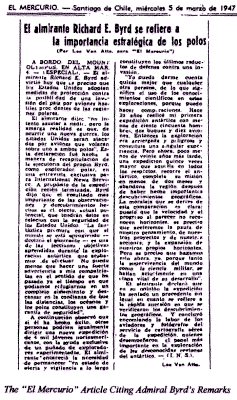
Admiral Byrd repeated the above points of view, resulting from his
personal knowledge gathered both at the north and south poles,
before a news conference held for International News Service.
At that time in history, of course, there was only one nation that
had undertaken anything like an extensive exploration of the
southern polar continent: Nazi Germany.
The Neu Schwabenland Expedition
In late 1938 the Germans undertook an expedition to
Antarctica, specially outfitting a seaplane carrier, the
Schwabenland for the purpose, and placing it under the command of
one of Germany's most experienced polar navigators.
At a cost of
some millions of Reichsmarks, the expedition was under the personal
direction and mentorship of none other than Luftwaffe chief,
Reichsmarschall Hermann Göring, which leaves one to wonder what
possible purpose Göring would have in sponsoring such an expedition.
[It is also to be noted that apparently the then Deputy Führer and
Party chief, Rudolf Hess, was also privy to whatever secret purpose
and findings this expedition had. Some people allege that this was
in part a hidden motivation for Hess's inexplicable flight to Great
Britain in 1941 to conduct secret "peace" negotiations with
representatives of the British Fascist movement.]
That it was military in nature seems beyond doubt, for the Nazis
spared no effort to outfit the expedition as thoroughly as possible.
New canning techniques were invented for the food needed on the
voyage from and back to Germany, and new clothing was designed,
including allegedly a,
"grey almost bullet proof seamless and
metallic appearing suit... made of whale skin."
[Christoph Friedrich,
Secret Nazi Polar Expeditions.]
The inspiration for the expedition
may have had hidden occult motivations as well, for the occult Thulegesellschaft or
Thule Society subscribed to a Nordic Atlantis
hidden beneath the polar ice, whence sprang, so the legend goes, the
Germanic race. [This fact would also place the expedition within the
brief of the SS Ahnenerbedienst.]
In any case, small teams of
specially selected biologists and other scientists accompanied the
expedition to run laboratory experiments on board the refurbished Schwabenland.
[The expedition is the subject of a fascinating novel
by William Dietrich called
Ice Reich. Dietrich's thesis is that the
Germans were after unknown microbial and bacteriological life forms
that were frozen in the ice and that could be transformed into
biological weapons.]
The Germans chose the region of Antarctica known as Queen Maud Land,
an area of the continent claimed by Denmark. In blatant disregard
for international law, the Nazis overflew the entire area, dropping
thousands of little swastika flags on the region with little spikes
to embed them in the ice, and claimed it for Germany, renaming the
region Neuschwabenland, but they did more than just fly and drop
flags.
The German pilots extensively photographed the region, and reported
mountain ranges in excess of 12,000 feet altitude, rocky crags
projecting above the fields of ice. But most amazingly, they
allegedly found ice-free ponds, heated geothermally, in which grew
various unknown species of algae. They also discovered the southern
tip of the fault line that runs from New Zealand, through
Neuschwabenland, and up the Atlantic Ocean, the famous Atlantic
"trench".
The Germans concluded that such features might indicate
the presence of rocky caverns on the continent, heated geothermally,
the perfect place for a hidden base in the world's most isolated,
desolate, and inaccessible wilderness.
Most intriguingly, the scientists aboard the Schwabenland were not
idle in analyzing the potential foodstuffs of the continent. It is
known that German dieticians were commissioned to prepare tasty and
nutritious meals using only what was available in Antarctica.
Emperor penguins were captured for return to Germany for study.
Walruses were shot and their bodies dissected. Their bodies were
tested for fat, protein, vitamin and other nutrient content. The
biological findings made during this expedition would occupy German
university scientists for months to come but the aim of this focus
was secret .
Clearly, if these allegations are true, then the Germans were
preparing for a relatively large and permanent presence on the
continent.

Then, via an unusual zigzagging route between Africa and South
America - itself one of the intriguing mysteries of the expedition -
the Schwabenland returned to Germany, reaching port on April 10,
1939. Göring presented the expedition members with written medals
and commemorations.
Then, all further mention of the expedition in
the German - or any other press - ceased.
So what do we have at this juncture?
-
Allegations from German writers
of known or suspected Nazi sympathies of a continued German
presence on the Antarctic continent during and after the war
-
Actual suspicious U-boat
activity in the South Atlantic at the end of the war
-
Allegations of German research
that could have been for no other purpose than establishment
of a permanent German presence on the continent
-
Allegations of discoveries of
small thermally heated ponds with unknown types of algae on
the continent's interior
-
Allegations of Grand Admiral Dönitz
that the U-boat fleet was involved in the construction of a
secret base or bases far from the Reich, one base of which
was surrounded by "eternal ice"
-
Allegations of a last sea battle
in the Atlantic prior to the German surrender, with things
going surprisingly disastrously for the Allies
-
An actual large postwar American
military adventure to the continent within two years of the
end of the war, with small accompanying international press
contingents, an expedition outfitted for eight months that
stayed only eight weeks
-
An actual newspaper report of Admiral Byrd trying to warn America of
a military threat from "enemy aircraft" flying from pole to pole at
tremendous speed.
All of this would seem to imply at a minimum that something was
going on in Antarctica, and that someone in the United States
Federal government was quite worried about it.
Indeed, when the United States returned to Antarctica some twelve
years later, it did so once again with force, this time, nuclear
force, and once again, under the cover of an "international
cooperative effort," the International Geophysical Year of 1957-
1958.
This means that if there were indeed Germans on a secret base
somewhere on that frozen continent, they had some twelve years to do
whatever they were doing. In terms of the Nazi legend, supposedly
they were busily perfecting their strange wartime research.
In any
case, as Henry Stevens points out, this period, from 1947 to
1957-58, is in fact the "golden age" of the flying saucer,
encompassing the
Kenneth Arnold sightings, the alleged
Roswell UFO
crash and recovery, to the famous "buzzing" of the Capital and White
House by UFOs that supposedly made even the unflappable Harry Truman
anxious.
[Stevens further speculates on the possible motivation for
the UFO overflights of sensitive areas of Washington DC:
"Was this overflight in retaliation for the Byrd overflight of the German base
in Antarctica and designed to show the Americans they had no control
over their own airspace?"
Stevens offers no evidence for this
speculation.
Supposing Stevens is correct for the sake of argument,
then suffice it to say that over-flights of the American capital by
Nazi flying saucers so long after the war's end would certainly have
shaken the national security apparatus of the United States much
more than over-flights by apparently benign extraterrestrial ones,
and the response would have been to clamp the lid down on government
research of the phenomenon, exactly as happened, since the
supposedly defeated enemy was not, if this is true, really defeated
after all.]
The famous
1952 Washington DC sightings prompted a
nervous and unconvincing Pentagon press conference - the only one
ever given by a general officer from the Pentagon - on the subject
of UFOs.
Under the cover of the geophysical year, the United States again
sent a naval task force to the Antarctic. The use of military force
– including atomic weapons! – was "covered" by the ridiculous story
that the USA and USSR, in a rare moment of nuclear cooperation
during the height of the Cold War, were interested in seeing how
much of the continent could be "recovered" for use by warming it
with nuclear explosions!
Accordingly, it would be necessary to
explode a few small nuclear "devices" for above the continent to
warm and melt the ice as a proof of concept!
As Stevens aptly quips,
"You already know exactly where in
Antarctica they planned to explode these atomic bombs."
Three bombs were thus detonated at an altitude of approximately 300
miles above the target, one on August 27, 1958, one on August 30,
1958, and a third on September 6, 1958.
[Stevens also notes that
these bursts may have something to do with the "ozone hole" over the
South Pole and the US government's reluctance to discuss the idea or
the events that may have caused it. Additionally, perhaps it is
possible that one atom bomb from each of the world's then nuclear
powers, the US, the USSR, and the UK, were used.]
If these bursts
were indeed intended secretly against an actual target, then why so
high?
Stevens hypothesizes that they were to knock out any German
equipment in the region by the strong electromagnetic pulse that
results from a nuclear detonation.
Stevens also notes that these
bursts may have something to do with the "ozone hole" over the South
Pole and the US government's reluctance to discuss the idea or the
events that may have caused it.

click above
image
While this is a plausible explanation if the intention were to
occupy the alleged base via a ground assault or assaults within the
time frame of the bursts, no such contingent is known to have
accompanied the small armada of two destroyers, two destroyer
escorts, and a small aircraft carrier.
However, this explanation
does bear some weight in connection with the allegations of the
capabilities of German bases at the other pole.
With the Geophysical
Year expedition of 1958's atomic detonations, the alleged German
base on the Antarctic continent fades, the Germans themselves
supposedly gradually evacuating it during the interim period from
Byrd's expedition to the final coup de grace for more favorable
climes in South America.
There the case for Nazi survival and
continued research becomes much stronger.
But before we can turn to
that, we must investigate the alleged German goings on at the other
pole.
Spitzbergen, Greenland, and Arctic Canada: The Other German Polar
Survival Myth
The Western Allies, the Russians, and the Germans all relied heavily
on weather reports to plan and execute their campaigns, and for this
purpose, accurate up-to-the-minute reporting on Arctic conditions
was crucial.
To this end it is not surprising to find the Germans in
particular outfitting special commando units - usually Waffen SS -
to operate independently in Spitzbergen Island north of Norway, in
Greenland, and in Arctic Canada. Such teams were delivered to their
operational areas via U-boat. Spitzbergen in particular seemed to
trade hands between the British and the Germans, as each side
mounted commando operations to destroy the other's weather stations
and listening posts.
On one such occasion, the most famous perhaps, the German battleship
Tirpitz, sister ship to the Bismarck, sailed to the island where one
such British station was operating, leveled her 15 inch heavy guns
at it, and promptly dispatched it, no doubt to the complete shock
and surprise of the British manning it.
Other allegations have a
secret German weather base and listening post operating in Franz
Josef Land, the islands to the north of Finland and the Soviet
Union.
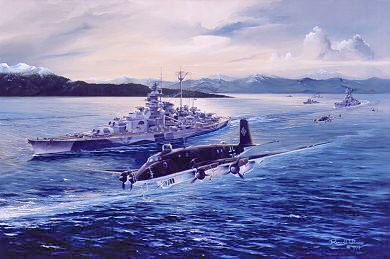
However, with the allegations of German bases in Greenland, one
again enters the realm of the surreal.
These bases were allegedly
comparatively large, as were the contingents of Germans operating
them. While they were supposedly known by the Greenlanders and
occupying American forces, most efforts to find them ended in
failure. One postwar German source places as many as three
independent SS battle groups (Kamfgruppen) operating in Greenland,
under the code name of Thulekampfgruppen (Thule battle groups).
The
connection to the occult interests of the Third Reich are once again
in evidence.
Predictably, these "Thule battle groups" become the subject of
another series of survival legends, as former SS officers supposedly
reported seeing U-boats loaded with rates designated "Thule 1 K" and
so on departing Germany in the final days of the war Sworn to
secrecy by the SS, the "clear implication is that the 'Thule 1 K' is
the Thule Kampfgruppe 1" and that it had "no intentions of
surrender; and that there was still a mission to accomplish.
The
Americans, so the story goes, were unsuccessful in locating them
bases for two reasons:
the area was too large, and the bases were, "like the German fortifications built in
Neuschwabenland... tunneled
deep underneath the glaciers of ice (into presumably solid rock) and
that they were bored to a length of 2000 meters."
[O. Bergmann,
Deutsche Flugsheiben und U-Boote Überwachen die Weltmeere.]
This allegation is surely implausible, since the transport of
sophisticated mining and boring equipment, let alone enough
explosive, for such a task by U- boat would have been an enormous
undertaking, one quite beyond the labor capabilities of small SS
battle groups – consider the fact that the huge underground
factories in Germany were built over several months by thousands of
slave laborers working around the clock with the best available
existing mining and tunneling technology.
But this is not the end of the surreal aspects of the story. Should
the bases have been detected, they were supposedly defended with
exotic electromagnetic weapons, one of which had a short range, but
that could cause the ignition of aircraft engines to fail
completely.
After the war, the Vienna Wiener Montag reported in its December 29,
1947 edition that Eskimos reported to American authorities that an
SS battle group of fully 150 men had been encountered.
The number
150 is realistic for a battle group, but quite below the labor
requirements for the construction of such large bases.
Besides these allegations of large bases and battle groups and
exotic weaponry, there is a similar account circulated by the
distinctly pro-Nazi novelist Wilhelm Landig in his 1971 novel
Götzen
gegen Thule, a novel he billed as "full of realities" (voller
Wirklichkeiten), of a large German base in the Canadian Arctic, near
the magnetic North pole.
|
Ultima Thule
In 1910, explorers Knud
Rasmussen and Peter Freuchen established an
outpost on the northwest coast of Greenland. They called
it Thule . The name is from the "Ultima Thule" of
ancient
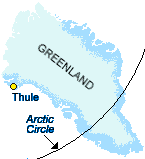 geographers,
referring to the farthest north land known to be
inhabited by humans. geographers,
referring to the farthest north land known to be
inhabited by humans.
In the early 1900s, the Inuit knew Thule as a trade,
medical and social center. Today it is the U.S. Armed
Forces' northernmost base which includes a Space Warning
Squadron and a Ballistic Missile Early Warning Site
designed to detect and track missiles launched against
North America.
When the base was planned, it was not known what the
coldest Arctic temperatures or strongest winds might be,
so everything was built to withstand temperatures as
cold as -100F / -73C and winds of up to 200 mph / 320 km
per hour.
Thule sits on 1600 feet/490 meters of permafrost, and as
long as everything stays frozen, the buildings sit on
solid ground. Ground level buildings have double floors
with cold air circulating between them, and other
buildings are well above ground to prevent the
permafrost from thawing out.
If it did, the buildings
would be sitting on a slushy mix of water and gravel. |
This base, he alleges, was serviced by the
German military using special long-range aircraft and, of course,
flying saucers!
As if that were not enough, Landig maintains that
these aircraft were not equipped with normal machine guns or cannon
for their defensive weaponry, but utilized a Metallstrahl,
essentially an electromagnetic "rail gun" used to propel tiny
pellets with extreme velocity, a kind of hyper-velocity shotgun that
would more than rip apart any Allied aircraft, and do so at great
distances.
All of these allegations would remain merely fanciful if it were not
for the discovery by American UFOlogist William Lyne - himself
definitely outside the "mainstream" of the UFOlogy community - of a
piece of German equipment that, quite literally, he bought at a
second-hand store in White Sands, New Mexico!
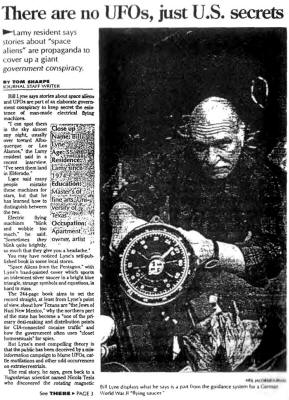
January 6, 1994
Albuquerque Journal North article featuring
William Lyne and His Mysterious Nazi Compass
[Lyne is the author of a rather extraordinary book of UFOlogy - a
field in which the extraordinary seems to be the norm - called
Space
Aliens from the Pentagon, the main theme of which is his adamant
insistence that UFOs are entirely terrestrial and man-made, and
being used to advance a fictitious "alien agenda" and psychological
operations campaign.
Lyne, notwithstanding the more often than not
unbelievable aspects of his book, was, in addition to Stevens, one
of the few UFOlogists to take the Nazi origins myth of UFOs
seriously prior to the publication of Nick Cook's
The Hunt for Zero
Point.]
The unusual thing about this piece of equipment was not only its
circular central swastika - a clear reference to the occult Thule Gesellschaft since that version of the swastika appeared on its
emblem - but also its designation as a Peiltochterkompass, a
"daughter compass."
Investigating this strange piece of equipment
further, Lyne concluded that it was no ordinary compass, since it
appeared not to operate by any magnetic means, which might explain
how it ended up in White Sands, New Mexico! Lyne and his mysterious
compass even became the subject of an article in a local American
newspaper.
Why is Lyne's find so important to the allegations of Nazi bases in
the Canadian Arctic that were being supplied by long range aircraft?
Very simple.
If there were ever any truth to the allegations of German bases in
these heavily forested regions, then normal magnetic compasses would
be of virtually no use for navigation purposes in the region, since
standard compasses are notoriously inaccurate at the polar regions
with solar energy cascading down and causing local disruptions of
the magnetic field.
Some other method, therefore, had to be found to
orient aircraft for safe navigation. Landig alleges that this was
done by means of a compass that oriented itself to the sun by
reading polarized light, rather than magnetic field lines. Lyne
therefore seems to have found some version of this compass in an
area of America known for its secret research laboratories some
twenty years or so after Landig's surreal allegations first
appeared!
But according to Landig there is even more to consider, for
according to him the German base in the Canadian Arctic was actively
researching and developing so-called "free energy" devices, devices
that would tap the so-called "zero point energy" of quantum
mechanics.
In this connection, the research was allegedly carried
out under the auspices of the SS Entwicklungstelle IV, or SS
"Developmental Installation IV," an entity, if it existed at all,
that would have fallen under the mission brief and jurisdiction of
Kammler's SS Sonderkommando, for it was responsible for "research
into making Germany independent of foreign energy sources."
So with Landig's fantastic allegations, we come full circle back to
the exotic energy sources, the technologies, the occult, and the SS
research being conducted by Nazi Germany.
To summarize the accumulated allegations and evidences:
-
Fact: The Germans undertook an expedition to Antarctica whose
hidden purpose was clearly military in nature, since one cannot
imagine the likes of Reichsmarschall Göring sponsoring an expedition
for any other purpose
-
Fact: The United States on two separate occasions over the wide
time-frame of eleven to twelve years undertook two large military
expeditions to that continent, both under appropriate cover stories
for mapping (the 1947 Byrd expedition, Operation Highjump, and for
the 1957-58 Geophysical Years (to study the effects of
atomic blasts on Antarctic weather!)
-
Fact: Admiral Byrd, the leader
of the first American expedition, was recorded in a South
American newspaper as warning of "enemy" aircraft capable of
violating American airspace with ease, and of flying form
pole to pole with tremendous speed
-
Fact: The German Navy showed great interest in the "free-energy"
ideas and coils of Hans Coler, for the ostensible purpose of
creating a means of submarine propulsion that would allow
German U-boats to stay submerged more or less indefinitely
-
Fact:
Admiral Byrd's diaries and logs
from his expedition are still classified
-
Fact: Coler's inventions were
highly classified by the German Navy, and later by the
British, who only declassified them over thirty years after
the war's end
-
Fact: The Germans had also
apparently contrived a sophisticated compass for possible
use in polar regions by aircraft, and possibly by other less
conventional aircraft
-
Fact: the alleged time span of
the German Antarctic base's survival is coincident with
"golden age" of the UFO, from the Arnold sightings, the
Roswell Crash, up to and beyond the great 1950s Washington
DC UFO flap
-
Fact: SS General Dr. Ing. Hans Kammler
had assumed total control of all the Third Reich's secret
weapons research by the end of the war, a position which
would have made him privy to the German Navy's research
-
Fact: It is evident from the movements of General Patton's
divisions in the closing days of the European war that Kammler's SS
secret weapons empire was the deliberate, and principal,
target of these military operations
-
Allegation: Grand Admiral Dönitz
on more than one occasion alluded to the role of the German
U-boat fleet in the construction of secret bases in polar
regions
-
Allegation: These bases were
staffed by SS troops, and presumably technicians conducting
ongoing secret research into "zero point energy" or "free
energy"
-
Allegation: Said research fell under an SS entity called S-IV,
recalling Kammler's S-III
-
Allegation: These bases were
said to be defended by exotic types of weaponry, including
electromagnetic "rail guns" to devices that could interfere
with and halt standard electrical engine ignitions systems
-
Allegation: There were secret SS
teams working on "areas of physics" even more exotic than
atomic and thermonuclear energy
-
Allegation: There is a connection to Nazi occult interests in
the polar regions via the myth of the pre-war occult
Thule Society (Thulegesellschaft)
-
Fact: The highest levels of the SS were initiates into
Himmler's occult inner circle at Wewelsburg, making it likely that
Kammler himself was such an initiate
-
Fact: The 1944 German atom bomb test at Rügen took place at a
location with its own occult pedigree and significance for the
pre-war Germanic, and very occult, Order of the New Templars
What emerges from this list is disturbing indeed.
Clearly, a prima
facie case can be made that the Nazi leadership had invested
significant resources in the investigation of any and all avenues to
power, occult and otherwise, and to new sources of energy.
And
equally clearly, the Nazi leadership was willing to think "outside
the box" and to go to any lengths - often quite literally - to
research those matters.
What also emerges from this list is a
preoccupation with areas of physics, and areas of the globe, almost
completely neglected - at least publicly - by the wartime Allies.
Moreover, what also emerges is a disturbing sense, that maybe, just
maybe, there was something to the survival myths after all, for one
thing seems clear from the pattern of events after the war,
particularly in respect to Antarctica:
Such myths were inevitably
connected to the exotic research pursuits the Germans were
conducting, and such myths seem clearly to have been the hidden
motivation for American counter-strikes.
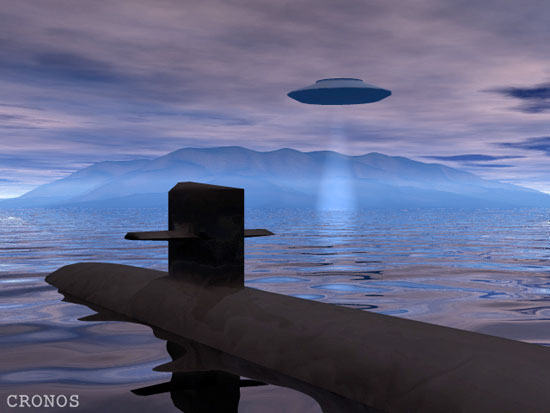
|








 geographers,
referring to the farthest north land known to be
inhabited by humans.
geographers,
referring to the farthest north land known to be
inhabited by humans.
